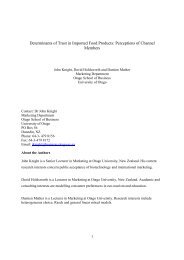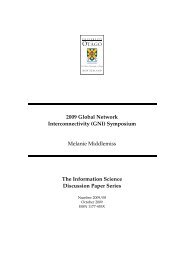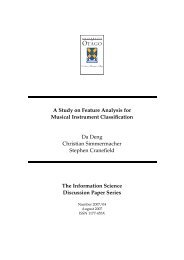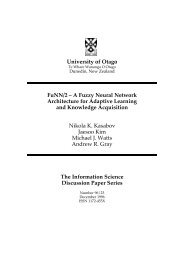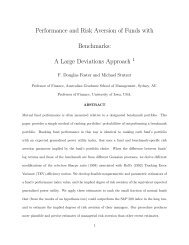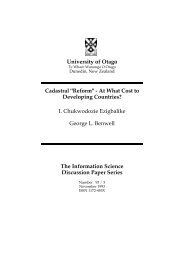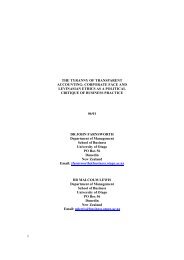Where is R2P grounded in international law? Anne-Marie Judson A ...
Where is R2P grounded in international law? Anne-Marie Judson A ...
Where is R2P grounded in international law? Anne-Marie Judson A ...
Create successful ePaper yourself
Turn your PDF publications into a flip-book with our unique Google optimized e-Paper software.
SUMMARY OF CHAPTER 3<br />
Th<strong>is</strong> research shows that there <strong>is</strong> jur<strong>is</strong>diction under the Charter of the United Nations<br />
and the International Court of Justice Statute for violations aga<strong>in</strong>st peace and security<br />
and <strong>in</strong>ternational <strong>law</strong>. Th<strong>is</strong> jur<strong>is</strong>diction applies to threats to the peace and violations<br />
of these which have been shown to <strong>in</strong>clude genocide and war crimes under the ICTY<br />
and ICTR. The rule of <strong>law</strong> showed that states are bound to each other through<br />
sign<strong>in</strong>g the Charter and the ICJ Statute <strong>in</strong> that they have responsibilities and duties <strong>in</strong><br />
<strong>in</strong>ternational <strong>law</strong> to prevent and protect their citizens from harm. The Vienna<br />
Convention showed the application pr<strong>in</strong>ciples on treaties and contracts between<br />
states. It showed that the state was limited <strong>in</strong> its actions by its obligations <strong>in</strong><br />
<strong>in</strong>ternational <strong>law</strong>. These obligations were shown as preventative tools <strong>in</strong> that the state<br />
had to implement the treaties <strong>in</strong> good faith <strong>in</strong>to local jur<strong>is</strong>diction and education to<br />
fulfill the conditions of the contract. If they did not it could be seen as a violation of<br />
<strong>in</strong>ternational <strong>law</strong> <strong>in</strong> pr<strong>in</strong>ciple. Other states could withdraw their commitment to the<br />
Treaty on behalf of the violation.<br />
Customary <strong>law</strong>s were shown also as prevention tools <strong>in</strong> that the obligations of each<br />
state to the Treaty provided <strong>in</strong>structions to comply with the rules of prosecution <strong>in</strong><br />
one’s own courts <strong>in</strong> regards to grave crimes. It also provided application rules <strong>in</strong><br />
regards to implement<strong>in</strong>g the Conventions, Statutes and Treaties <strong>in</strong>to local leg<strong>is</strong>lation,<br />
military programmes and local education. In terms of <strong>in</strong>dividual def<strong>in</strong>itions, ethnic<br />
cleans<strong>in</strong>g was shown to have d<strong>is</strong>t<strong>in</strong>ctive reference to race, based on d<strong>is</strong>crim<strong>in</strong>ation,<br />
and it could be considered under apartheid or genocide. War crimes and genocide<br />
were firmly <strong>grounded</strong> <strong>in</strong> <strong>in</strong>ternational <strong>law</strong> provid<strong>in</strong>g detailed <strong>in</strong>formation on their<br />
application. On the other hand research showed that the application of crimes aga<strong>in</strong>st<br />
humanity had failed under the Nuremberg and the Tokyo Trials. The establ<strong>is</strong>hment<br />
of the Tribunals of the former Yugoslavia and Rwanda also showed that the<br />
term<strong>in</strong>ology could not yet be d<strong>is</strong>t<strong>in</strong>ctively applied as customary <strong>in</strong>ternational <strong>law</strong> on<br />
its own. Th<strong>is</strong> ra<strong>is</strong>ed questions of applicability and legal stand<strong>in</strong>g <strong>in</strong> relation to <strong>R2P</strong><br />
application. The question was ra<strong>is</strong>ed regard<strong>in</strong>g applicability <strong>in</strong> circumstances that<br />
cannot be def<strong>in</strong>ed as war crimes where there must be two parties or more to a conflict<br />
to be def<strong>in</strong>ed under war crimes. Th<strong>is</strong> question was left unanswered <strong>in</strong> Chapter 3 and<br />
further clarification of these questions will be provided <strong>in</strong> Chapter 4.<br />
<br />
95




